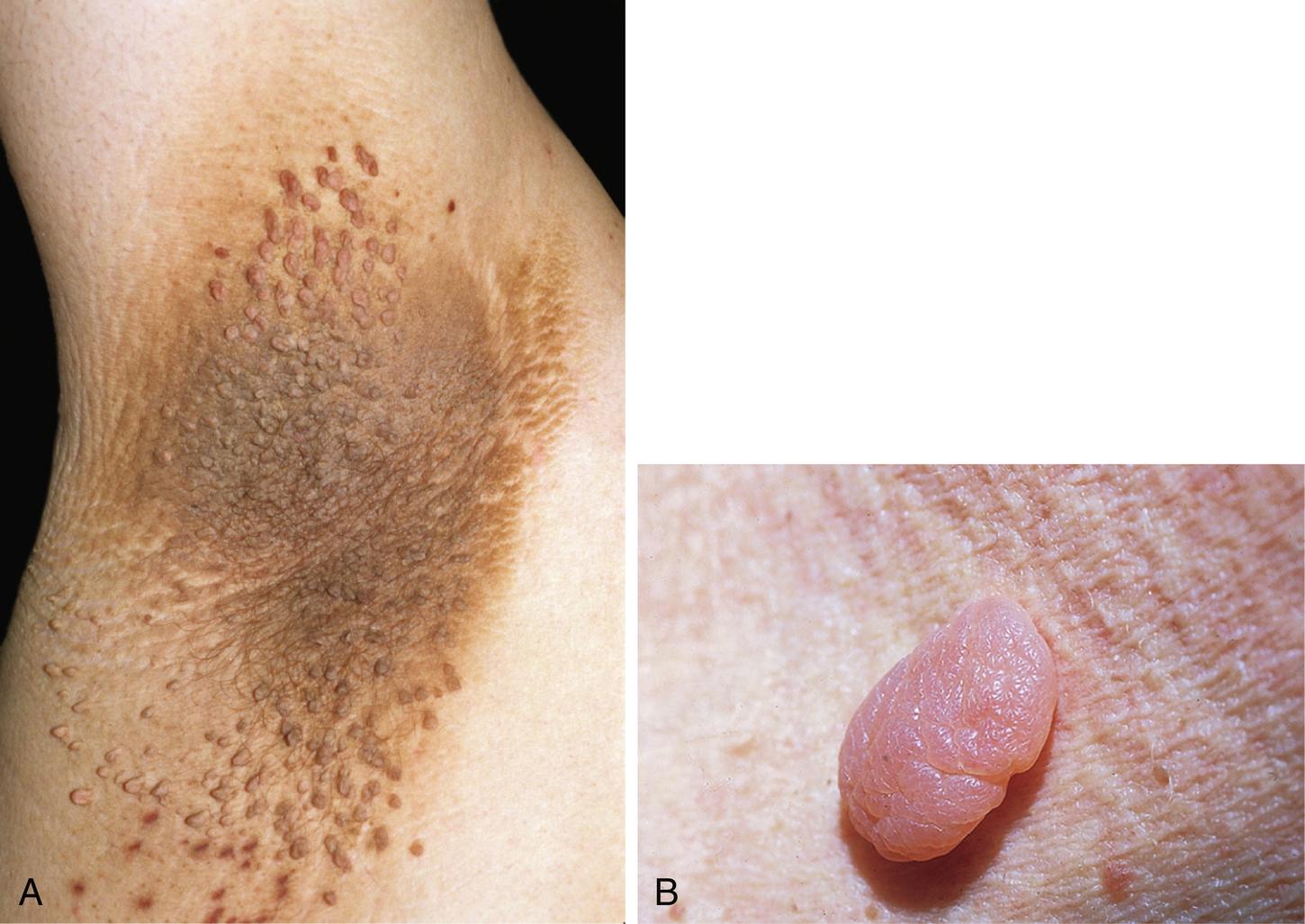Physical Address
304 North Cardinal St.
Dorchester Center, MA 02124
Tumors of fibrous tissue (“soft tissue tumors”) are typically mesenchymal tumors composed of fibroblasts and variants of fibroblasts. Fibroblasts produce the structural components of the dermis, including collagen, elastin, and ground substance (dermal mucin). Some tumors are composed of myofibroblasts, which are specialized fibroblasts with contractile properties afforded by cytoplasmic actin filamets. Other specialized fibroblasts demonstrate histiocytic properties and are referred to as fibrohistiocytic. Benign soft tissue neoplasms are often divided into fibrous tumors and fibrohistiocytic tumors ( Table 42.1 ). Malignant fibrous and fibrohistiocytic tumors are covered in Chapter 46.
| Benign fibrous tumors | Benign fibrohistiocytic tumors |
|---|---|
|
|
An acrochordon (skin tag, fibroma durum) is a soft, often pedunculated, flesh-colored to dark brown cutaneous papule, usually located on flexural surfaces, such as the neck, axilla, or groin ( Fig. 42.1 A ). Acrochordons are ubiquitous. Acrochordons are most often multiple, usually 1 to 4 mm in size, but occasionally may be 3 cm or larger in diameter. Larger lesions often contain some fat and are also called fibroepithelial polyps ( Fig. 42.1 B).

The precise cause is unknown. Acrochordons are associated with diabetes mellitus, obesity, pregnancy, menopause, acanthosis nigricans (see Fig. 42.1 A), metabolic syndrome, and certain endocrinopathies, suggesting hormonal induction. However, the ubiquitous nature of these lesions, particularly in healthy older adults, means acrochordons may also simply be a manifestation of aging skin.
Shah R, Jindal A, Patel N. Acrochordons as a cutaneous sign of metabolic syndrome: a case-control study. Ann Med Health Sci Res. 2014;4:202–205.
The most common complications pertain to trauma, torsion, and infarction of a pedunculated lesion. When a pedunculated lesion twists on its stalk, the blood supply may be compromised with resultant tissue ischemia. Sudden pain, swelling, necrosis, and even secondary infection can result. Often, this sequence of events results in disappearance of the acrochordon.
Although early studies suggested a significant association between acrochordons and colonic polyps, more recent studies, using sounder methodology, did not demonstrate an association.
A simple way to treat acrochordons is scissor-snip excision (even without anesthesia). Smaller lesions can be treated by electrodessication or cryotherapy (beware of postinflammatory hypopigmentation with cryotherapy). Larger lesions (> 1 cm) can be shaved off after local anesthesia.
Excessive collagen deposition at a site of wound healing leads to a hypertrophic scar. Typically, hypertrophic scars are erythematous, raised, firm, and pruritic. With time, hypertrophic scars flatten and become white. Unlike keloids, hypertrophic scars do not extend beyond the limits of the original trauma. Scars, including hypertrophic scars, are not usually considered to be neoplasms because they are reactive and eventually regress with time.
A keloid is also caused by excessive collagen deposition at a wound site, but typically the deposition in a keloid is more exaggerated. Microscopically, keloids are differentiated from hypertrophic scars by the presence of large eosinophilic collagen bundles, with abundant mucin. Keloids frequently proliferate beyond the bounds of the original trauma, and this is different from hypertrophic scars. Some keloids, particularly on the sternum or upper back, may develop without identifiable preceding trauma. Keloids do not typically involute.
In early lesions, it may be impossible to make this distinction, but in developed lesions, the features listed in Table 42.2 are useful.
| Hypertrophic scar | Keloid |
|---|---|
| Any age group, especially children | Adolescents and young adults |
| All racial and ethnic groups | Blacks and Asians > Caucasians |
| No familial tendency | Familial tendency |
| Limited to sites of trauma | Sites of trauma or spontaneous |
| Onset within 2 months | Onset within 1 year |
| Any anatomic site | High-risk anatomic site |
| Dome-shaped lesions | Dome-shaped, exophytic, or crablike extensions |
| Confined to site of trauma | Extends into normal skin |
| Improved by corrective surgery | Often worsened by surgery |
| Spontaneous regression | No spontaneous regression |
Become a Clinical Tree membership for Full access and enjoy Unlimited articles
If you are a member. Log in here